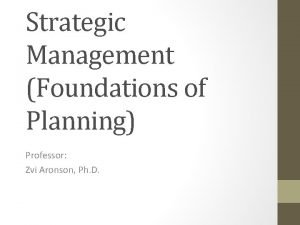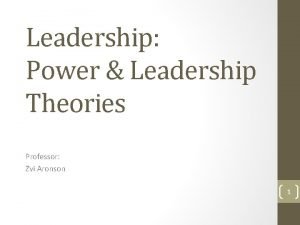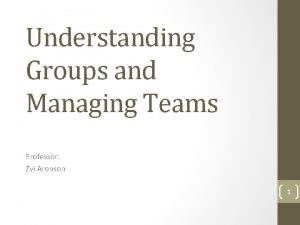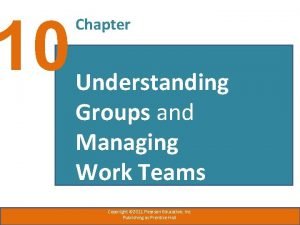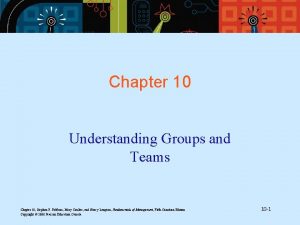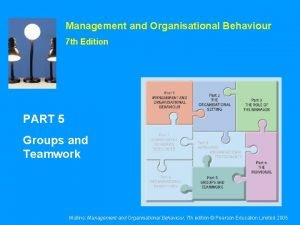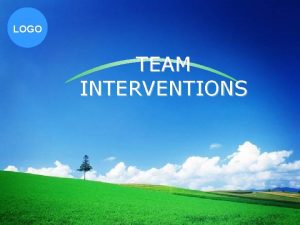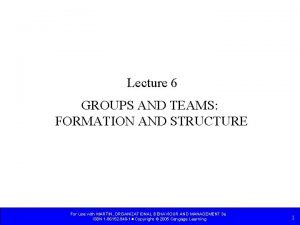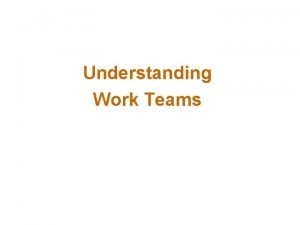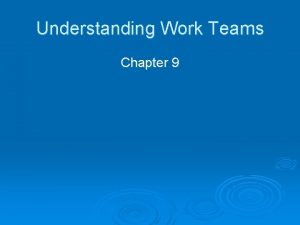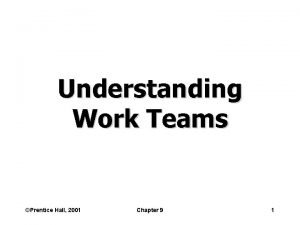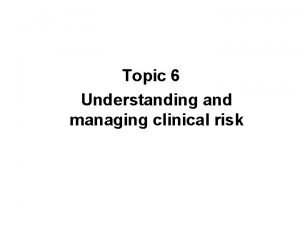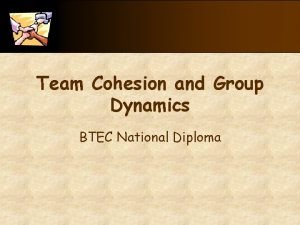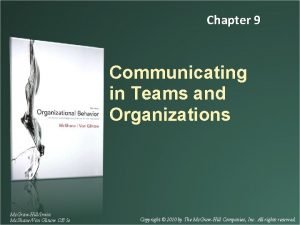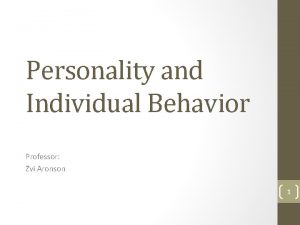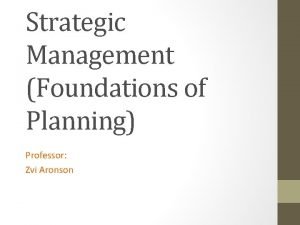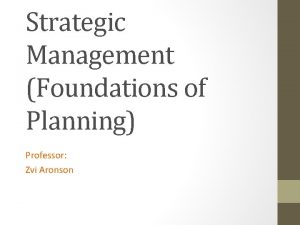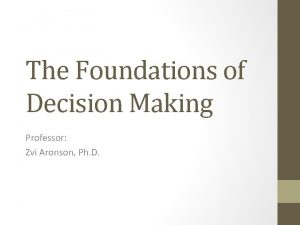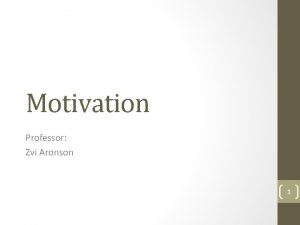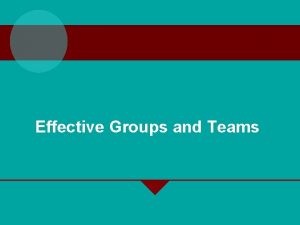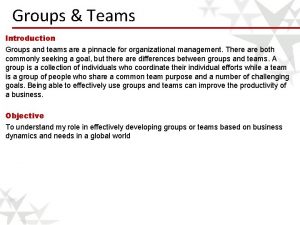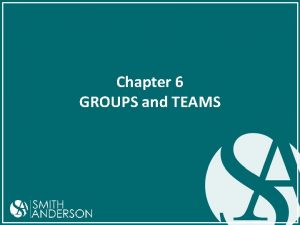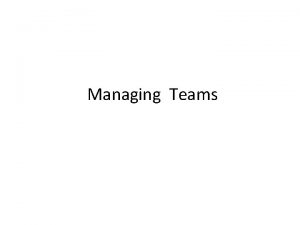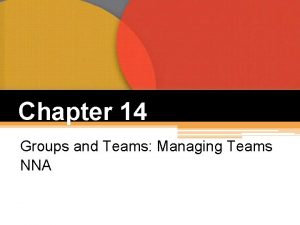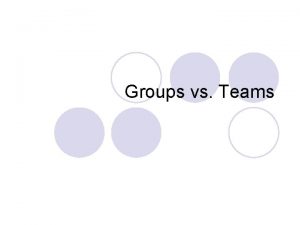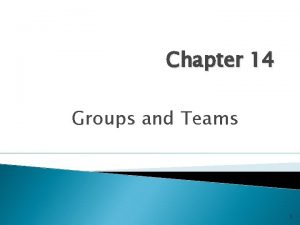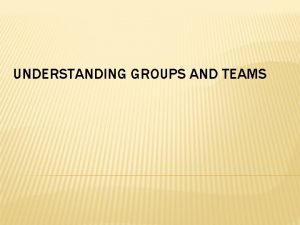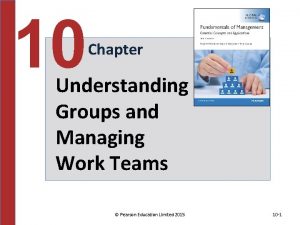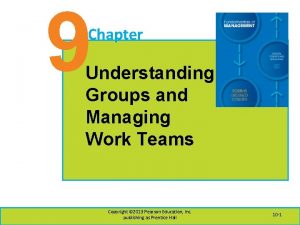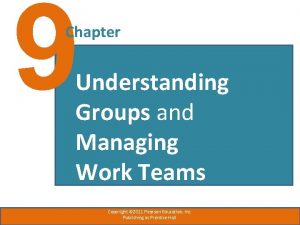Understanding Groups and Managing Teams Professor Zvi Aronson



































- Slides: 35

Understanding Groups and Managing Teams Professor: Zvi Aronson 1

Groups and Teams • A group or team has two or more individuals, interacting and interdependent, who come together to achieve particular objectives • A group and team can be formal or informal • A (good) team (not a group) generates positive synergy through coordinated effort.

Individual versus Group/Team Decision Making Individual • • • More efficient Speed No meetings No discussions Clear accountability Consistent values Group/Team • More effective • More information and knowledge • Diversity of views • Higher-quality decisions • Increased acceptance

Effect of Culture on Social Loafing Standardized Performance Measure In the collectivistic cultures of China and Israel, people performed better as part of a group than alone In the United States, people performed better alone than in groups (i. e. , social loafing occurred) Perform in groups Perform alone Peoples Republic of China Israel United States

When Are Groups/Teams Not the Answer? • Teamwork takes more time and often more resources than does individual work • Teams require managers to communicate more, manage conflicts, and run meetings • The benefits of using teams need to exceed the costs

Synergy + + + = The whole is greater than the sum of the parts.

Types of Work Groups/Teams • Command Groups – Groups that are determined by the org chart and report to a specific manager • Task Groups – Groups brought together to perform a specific task. Usually temporary, and disband when task is complete. • Problem-Solving Teams - A team from the same department or functional area that’s involved in efforts to improve work activities or to solve specific problems • EX – Customer Service Teams

Types of Teams (cont. ) • Self-Managed Work Team - A type of work team that operates without a manager and is responsible for a complete work process or segment • Cross-Functional Team -Teams made up of individuals from various departments and that cross traditional departmental lines • Virtual Team - A type of work team that uses technology to link physically dispersed members in order to achieve a common goal

Stages of Team Development Synergy happens here Performing Norming ? ? Storming ? Forming Adjourning

AN EXAMPLE: LOUISVILLE AND THE KEVIN WARE INJURY 10

Copyright © 2011 Pearson Education, Inc. Publishing as Prentice Hall. 9 -20

Social Loafing Amount of Individual Group Performance 12 High The more people working on a group task, the smaller the contribution made by any one member of the group will be Low One person Small working alone group Large group

Does Group Size Affect Behavior? Large Groups • are good for gaining diverse input Small Groups • Are typically faster at implementation • Better for building relationships • Social Loafing • The tendency for individuals to expend less effort when working collectively than when working individually

Team Conformity • Informational influence: We depend on others for reliable information about true states of the world; if others disagree, maybe we’re missing something important • Normative influence: We fear social disapproval • Conformity is the most common problem among decision-making groups 14 • Why does conformity occur?

Examples of Cards Used in Asch Study X A B C

Groupthink: The Result of Extreme Conformity Pressure • Overestimation of group’s power/morality: Illusion of invulnerability, unquestioned belief in group’s morality • Closed-mindedness: Collective efforts to rationalize, stereotyped view of outgroup leaders • Pressures toward uniformity: Self-censorship of deviations, illusion of unanimity, direct pressure to conform or be silent, selfappointed “mindguards” 16 • A concurrence-seeking tendency among cohesive group members that features over-optimism, closed-mindedness and pressures to conform and that leads to failed decisions

• • Leaders should assign each member the role of “critical evaluator”. This allows each member to freely air objections and doubts. Higher-ups should not express an opinion when assigning a task to a group. The organization should set up several independent groups, working on the same problem. All effective alternatives should be examined. Each member should discuss the group's ideas with trusted people outside of the group. The group should invite outside experts into meetings. Group members should be allowed to discuss with and question the outside experts. At least one group member should be assigned the role of Devil’s advocate, and that person should be different at each meeting. 17 Avoiding Groupthink and Conformity

According to the book, “The 5 Dysfunctions of Teams” Inattention to RESULTS Avoidance of ACCOUNTABILITY Lack of COMMITMENT Fear of CONFLICT Absence of TRUST Source: Lencioni, P. , 2003. “The 5 Dysfunctions of Teams”, New York: Josey Bass.

Take the 5 Dysfunction Test… 19

Dysfunction 1: Absence of Trust ……………………………. . . • • Conceal their weaknesses and mistakes from one another Hesitate to ask for help or provide constructive feedback Hesitate to offer help outside their own areas of responsibility Jump to conclusions about the intentions and aptitudes of others without attempting to clarify them Fail to recognize and tap into one another’s skills and experiences Waste time and energy managing their behaviors for effect Hold grudges Dread meetings and find reasons to avoid spending time together 20 Members of teams with an absence of trust…

Dysfunction 1: Absence of Trust ……………………………. . . • • • Admit weaknesses and mistakes Ask for help Accept questions and input about their areas of responsibility Give one another the benefit of the doubt before arriving at a negative conclusion Take risks in offering feedback and assistance Appreciate and tap into one another’s skills and experiences Focus time and energy on important issues, not politics Offer and accept apologies without hesitation Look forward to meetings and other opportunities to work as a group 21 Members of trusting teams…

Dysfunction 1: Absence of Trust ……………………………. . . • • • Personal Histories Exercise Team Effectiveness Exercise Personality Behavioral Preference Profiles 360 -Degree Feedback Experiential Team Exercises 22 Suggestions for Overcoming Dysfunction 1

Dysfunction 2: Fear of Conflict ……………………………. . . • Have boring meetings • Create environments where back-channel politics and personal attacks thrive • Ignore controversial topics that are critical to team success • Fail to tap into all the opinions and perspectives of team members • Waste time and energy with posturing and interpersonal risk management 23 Teams that fear conflict…

Dysfunction 2: Fear of Conflict ……………………………. . . • • • Have lively, interesting meetings Extract and exploit the ideas of all team members Solve real problems quickly Minimize politics Put critical topics on the table for discussion 24 Teams that engage in conflict…

Dysfunction 2: Fear of Conflict ……………………………. . . • • Mining Devil’s Advocacy Real-Time Permission Other Tools (e. g. , conflict management style assessment) 25 Suggestions for Overcoming Dysfunction 2

Dysfunction 3: Lack of Commitment ……………………………. . . • Creates ambiguity among the team about direction and priorities • Watches windows of opportunity close due to excessive analysis and unnecessary delay • Breeds lack of confidence and fear of failure • Revisits discussions and decisions again and again • Encourages second-guessing among team members 26 A team that fails to commit…

Dysfunction 3: Lack of Commitment ……………………………. . . • • • Creates clarity around direction and priorities Aligns the entire team around common objectives Develops an ability to learn from mistakes Takes advantage of opportunities before competitors do Moves forward without hesitation Changes direction without hesitation or guilt 27 A team that commits…

Dysfunction 3: Lack of Commitment ……………………………. . . • • Cascading Messaging Deadlines Contingency and Worst-Case Scenario Analysis Low-Risk Exposure Therapy 28 Suggestions for Overcoming Dysfunction 3

Dysfunction 4: Avoidance of Accountability ……………………………. . . • Creates resentment among team members who have different standards of performance • Encourages mediocrity • Misses deadlines and key deliverables • Places an undue burden on the team leader as the sole source of discipline 29 A team that avoids accountability…

Dysfunction 4: Avoidance of Accountability ……………………………. . . • Ensures that poor performers feel pressure to improve • Identifies potential problems quickly by questioning one another’s approaches without hesitation • Establishes respect among team members who are held to the same high standards • Avoids excessive bureaucracy around performance management and corrective action 30 A team that holds one another accountable…

Dysfunction 4: Avoidance of Accountability ……………………………. . . • Publication of Goals and Standards, including who needs to deliver what and how everyone must behave in order to succeed. • Simple and Regular Progress Reviews that include honest direct feedback • Team Rewards 31 Suggestions for Overcoming Dysfunction 4

Dysfunction 5: Inattention To Results ……………………………. . . Stagnates/fails to grow Rarely defeats competitors Loses achievement-oriented employees Encourages team members to focus on their own careers and individual goals • Is easily distracted • • 32 A team that is not focused on results…

Dysfunction 5: Inattention To Results ……………………………. . . Retains achievement-oriented employees Minimizes individualistic behavior Enjoys success and suffers failure acutely Benefits from individuals who subjugate their own goals/interests for the good of the team • Avoids distractions • • 33 A team that focuses on collective results…

Dysfunction 5: Inattention To Results ……………………………. . . Suggestions for Overcoming Dysfunction 5 34 • Public Declaration of Commitment to Results • Results-Based Rewards

• • • Social loafers (aka, Jokers/Avoiders) Aggressors Blockers Dominators Recognition Seekers 35 Avoiding Dysfunctional Roles
 Zvi aronson
Zvi aronson Zvi aronson
Zvi aronson Zvi aronson
Zvi aronson Understanding groups and teams
Understanding groups and teams Understanding groups and teams
Understanding groups and teams Understanding groups and teams
Understanding groups and teams What's the difference between group and team
What's the difference between group and team Groups and teams difference
Groups and teams difference Groups and teams difference
Groups and teams difference Igor aronson
Igor aronson Team vs working group
Team vs working group Why have teams become so popular
Why have teams become so popular Why have teams become so popular
Why have teams become so popular Understanding work teams
Understanding work teams Promotion from assistant to associate professor
Promotion from assistant to associate professor Managing clinical risk
Managing clinical risk Zvi margaliot
Zvi margaliot Zvi margaliot
Zvi margaliot Zvi wiener
Zvi wiener Zvi kedem
Zvi kedem Zvi tools
Zvi tools Dr zvi margaliot
Dr zvi margaliot Zvi roth
Zvi roth Zvi wiener
Zvi wiener How are ethnic groups and religious groups related
How are ethnic groups and religious groups related Reinforcement theory of motivation
Reinforcement theory of motivation Motivating and satisfying employees and teams
Motivating and satisfying employees and teams Is the individual internal process that energizes directs
Is the individual internal process that energizes directs Motivating and satisfying employees and teams
Motivating and satisfying employees and teams Copyright
Copyright Team cohesion examples
Team cohesion examples Peopleware: productive projects and teams
Peopleware: productive projects and teams Persuasive communication
Persuasive communication Leading and working in teams
Leading and working in teams Long oo sound words
Long oo sound words The professor's beloved equation full movie
The professor's beloved equation full movie
